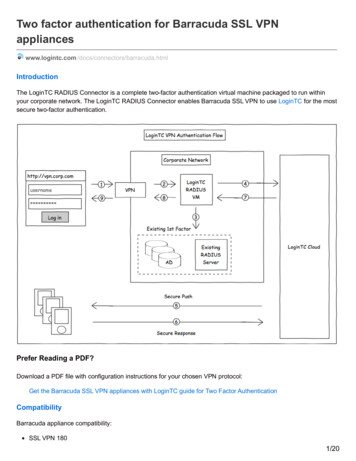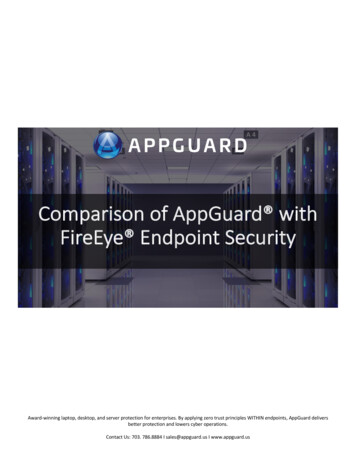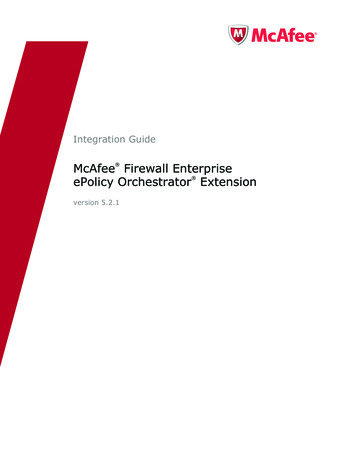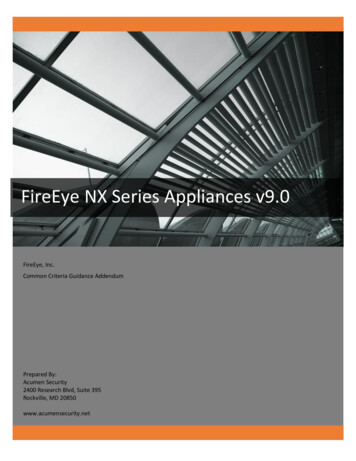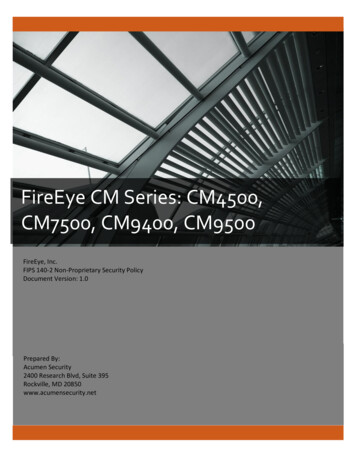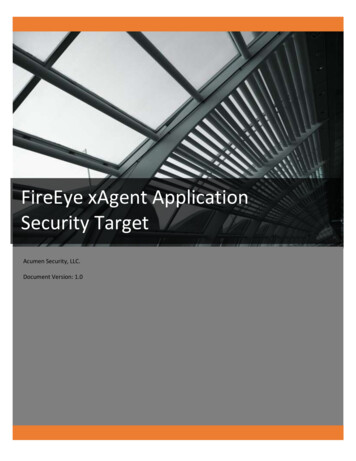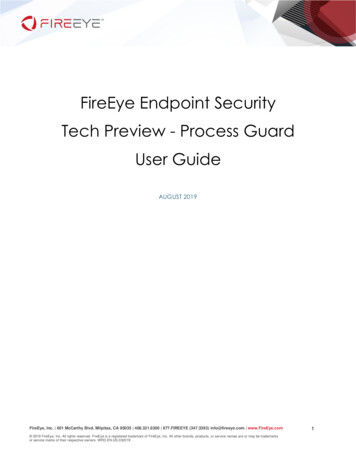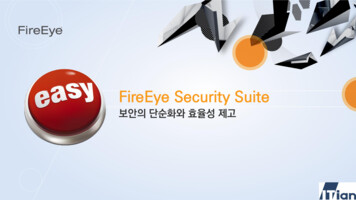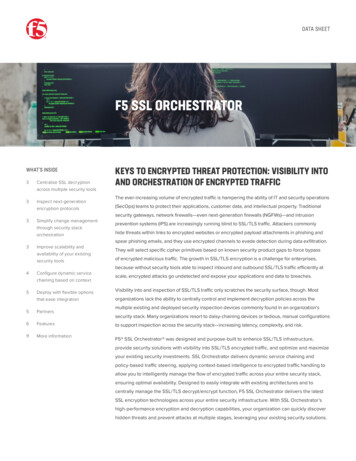
Transcription
RECOMMENDED PRACTICES GUIDEF5 SSL Orchestrator and FireEye NX:SSL Visibility with Service ChainingJanuary 20191
ContentsIntroduction . 3The integrated F5 and FireEye solution . 3Solution Overview . 4Dynamic service chaining . 5Topologies . 6License components . 6Sizing . 7Traffic exemptions for SSL inspection . 7Best Practices for the Joint Solution . 8Architecture best practices . 8Security best practices . 8Certificate requirements. 8Initial Setup . 9Configure the VLANs and self-IPs . 9Import a CA certificate and private key . 9Update the SSL Orchestrator version . 9SSL Orchestrator Configuration . 10Guided configuration . 11Guided configuration workflow . 12Testing the Solution . 202
RECOMMENDED DEPLOYMENT PRACTICESF5 and FireEye NX: SSL Visibility with Service ChainingIntroductionSSL/TLS has been widely adopted by organizations to secure IP communications. While SSL provides data privacy andsecure communications, it also creates challenges to security infrastructure components. In short, the encryptedcommunications cannot be seen like clear text and thus are passed through without inspection, rendering any defensein-depth security architecture ineffective. This creates significant risks to businesses: What if attackers are hidingmalware inside the encrypted traffic?Today’s security devices, such as intrusion prevention systems (IPSs) and next-generation firewalls (NGFWs), lack theprocessing power to easily decrypt SSL/TLS traffic, especially given the demands of 2048-bit certificates. Theprocessing capacity of these security devices is further reduced when they are deployed inline, taking not only theinteresting traffic that needs to be inspected, but all the wire traffic. Deploying these devices in monitoring modeconserves system resources, but at a cost: They alert administrators to threats but do not block them.An integrated F5 and FireEye solution solves these two SSL/TSL challenges. The FireEye Threat Prevention Platformprovides real-time, dynamic threat protection without the use of signatures to protect an organization across the primarythreat vectors and the stages of an attack life cycle. Meanwhile, F5 SSL Orchestrator centralizes SSL inspectionacross complex security architectures, providing flexible deployment options to decrypt and re-encrypt user traffic. Italso provides intelligent traffic orchestration using dynamic service chaining and policy-based management. Thedecrypted traffic is then inspected by one or more FireEye NX devices, which can prevent previously hidden threats andblock zero-day web exploits. This solution eliminates the blind spots introduced by SSL and closes any opportunity foradversaries.This overview of the joint solution discusses different deployment modes with reference to service chain architectures,recommended practices, and guidance on how to handle enforcement of corporate Internet use policies.The integrated F5 and FireEye solutionThe integrated F5 and FireEye advanced threat protection solution enables organizations to intelligently manage SSLwhile providing visibility into a key threat vector that attackers often use to exploit vulnerabilities, establish commandand control channels, and steal data. Without SSL visibility, it is impossible to identify and prevent such threats at scale.Key highlights of the joint solution include: Flexible deployment modes that easily:oIntegrate into even the most complex architectures.oConsolidate the security stack to reduce complexity.oDeliver SSL visibility across the security infrastructure.Centralized SSL decryption/re-encryption with best-in-class SSL hardware acceleration, eliminating theprocessing burden of multiple decryption/re-encryption workloads on every security inspection hop in thestack. This reduces latency while improving the user experience.3
RECOMMENDED DEPLOYMENT PRACTICESF5 and FireEye NX: SSL Visibility with Service Chaining Dynamic security service chaining, which provides policy-based traffic management and determineswhether traffic should be allowed to pass or be decrypted and sent through a security device or service. An industry-leading application delivery controller that load balances traffic to multiple devices in thesecurity services, enabling effortless scaling and growth. Built-in health monitors that detect security service failures and shifts or bypasses loads in real time toprovide reliability and fault tolerance. Full cipher support, including support for perfect forward secrecy (PFS)-enabled ciphers, to ensure fulltraffic visibility. Right-sizing of the security infrastructure, sending only appropriate traffic through security controls viaservice chains and URL filtering. Coordinated support from FireEye and F5.Solution OverviewF5’s industry-leading full proxy architecture enables SSL Orchestrator to install a decryption/clear text zone between theclient and web server, creating an aggregation (and, conversely, disaggregation) visibility point for security services.The F5 system establishes two independent SSL connections—one with the client and the other with the web server.When a client initiates an HTTPS connection to the web server, the F5 system intercepts and decrypts the clientencrypted traffic and steers it to a pool of FireEye NX devices for inspection before re-encrypting the same traffic to theweb server. The return HTTPS response from the web server to the client is likewise intercepted and decrypted forinspection before being sent on to the client.Figure 1: The F5 full proxy architecture4
RECOMMENDED DEPLOYMENT PRACTICESF5 and FireEye NX: SSL Visibility with Service ChainingDynamic service chainingA typical security stack often consists of more than advanced anti-malware protection systems, with additionalcomponents such as a firewall, intrusion detection or prevention systems (IDS/IPS), web application firewalls, malwareanalysis tools, and more. To solve specific security challenges, administrators are accustomed to manually chainingthese point security products. In this model, all user sessions are provided the same level of security, as this “daisychain” of services is hard-wired.F5 SSL Orchestrator not only decrypts the encrypted traffic, it also load balances, monitors, and dynamically chainssecurity services, including next-generation firewalls, DLPs, IDS/IPSs, web application firewalls, and anti-virus/antimalware systems. It does this by matching user-defined policies, which determine what to intercept and whether to senddata to one set of security services or another based on context. This policy-based traffic steering enables betterutilization of existing security investments and helps reduce administrative costs.Figure 2: A service chainSSL Orchestrator’s powerful classification engine applies different service chains based on context derived from: Source IP/subnet. Destination IP/subnet. An F5 IP Intelligence category subscription. IP geolocation. Host and domain name. An F5 URL filtering category subscription. Destination port. Protocol.5
RECOMMENDED DEPLOYMENT PRACTICESF5 and FireEye NX: SSL Visibility with Service ChainingTopologiesDifferent environments call for different network implementations. While some can easily support SSL visibility at layer 3(routed), others may require these devices to be inserted at layer 2. SSL Orchestrator can support all these networkingrequirements with the following topology options: Outbound transparent proxy Outbound explicit proxy Outbound layer 2 Inbound reverse proxy Inbound layer 2 Existing applicationLicense componentsThe F5 SSL Orchestrator product line—the i2800, i5800, i10800, i11800, i15800, and Virtual Edition High Performance(HP)—supports this joint solution. SSL Orchestrator devices ship with an installed base module that provides both SSLinterception and service chaining capabilities. Please contact your local F5 representative to further understand thelicensing and deployment options.Unless otherwise noted, references to SSL Orchestrator and the F5 BIG-IP system in this document (andsome user interfaces) apply equally regardless of the F5 hardware used. The solution architecture andconfiguration are identical.Optionally, customers can add the functionality of: An F5 URL filtering (URLF) subscription to access the URL category database. An F5 IP Intelligence subscription for IP reputation service. A network hardware security module (HSM) to safeguard and manage digital keys for strongauthentication. F5 Secure Web Gateway (SWG) Services to filter and control outbound web traffic using a URL database. F5 BIG-IP Access Policy Manager (APM) to authenticate and manage user access. A BIG-IP Local Traffic Manager (LTM) add-on software license mode. This solution is supported on all F5BIG-IP iSeries and older F5 hardware platforms with no specific restrictions on additional F5 software modules(including the software services listed above). This option is suited for environments that need to deploy SSLOrchestrator on an existing BIG-IP device or have other functions that must run on the same device.To deploy the joint solution, the FireEye component must first be installed. FireEye NX supports inline (L2) mode as wellas TAP mode operations. Refer to the FireEye technical documentation for complete guidance.6
RECOMMENDED DEPLOYMENT PRACTICESF5 and FireEye NX: SSL Visibility with Service ChainingSizingThe main advantage of deploying SSL Orchestrator in the corporate security architecture is that wire traffic now can beclassified either as “interesting” traffic, which needs to be decrypted by SSL Orchestrator for inspection by FireEye NX,or “uninteresting” traffic, which is allowed to pass through or be processed differently according to other corporate policyrequirements. This selective steering of only the interesting traffic to FireEye NX conserves its valuable resources (as itneed not inspect all wire traffic), maximizing performance.As a result, it is important to consider the entire wire traffic volume to calculate the appropriate F5 device size. TheFireEye NX system will require two interfaces on the F5 systems (or one 802.1q VLAN tagged interface) to allow trafficflow through logical inbound and outbound service interfaces.Refer to the SSL Orchestrator Datasheet and consider the following factors when sizing the F5 system for the integratedsolution: Port density SSL bulk encryption throughput System resources The number of security services and devices in the service chain(s)Traffic exemptions for SSL inspectionAs noted, the F5 system can be configured to distinguish between interesting and uninteresting traffic for the purposesof security processing. Examples of uninteresting traffic (including those types that cannot be decrypted) that may beexempted from inspection include: Guest VLANs. Applications that use pinned certificates. Trusted software update sources like those for Microsoft Windows. Trusted backup solutions, such as a crash plan. Any lateral encrypted traffic to internal services.Administrators can also exempt traffic based on domain names and URL categories. The policy rules of the F5 SSLOrchestrator system enable administrators to enforce corporate Internet use policies, preserve privacy, and meetregulatory compliance.Traffic exemptions based on URL category might include bypasses (and thus no decryption) for traffic from knownsources of these types of traffic: Financial Health care Government services7
RECOMMENDED DEPLOYMENT PRACTICESF5 and FireEye NX: SSL Visibility with Service ChainingBest Practices for the Joint SolutionA number of best practices can help optimize the performance and reliability, as well as the security, of the jointsolution.Architecture best practicesTo ensure a streamlined architecture, F5 recommendations include: Deploy inline. Any SSL visibility solution must be inline to the traffic flow to decrypt PFS cipher suites such asECDHE (elliptic curve Diffie-Hellman encryption). Deploy SSL Orchestrator in a device sync/failover device group (S/FDG) that includes the high-availability (HA) pairwith a floating IP address. Use dual-homing. The FireEye NX devices must be dual-homed on the inward and outward VLANs with each F5system in the device S/FDG. Achieve further interface redundancy with the Link Aggregation Control Protocol (LACP). LACP manages theconnected physical interfaces as a single virtual interface (aggregate group) and detects any interface failureswithin the group.Security best practicesSSL orchestration generally presents a new paradigm in the typical network architecture. Previously, client/server trafficpassed encrypted to inline security services, which then had to perform their own decryption if they needed to inspectthat traffic. When SSL Orchestrator is integrated into the security architecture, all traffic bound for a security device isdecrypted—including user names, passwords, social security and credit card numbers, etc. It is therefore highlyrecommended that organizations isolate security services within a private, protected enclave defined by SSLOrchestrator.It is technically possible to configure SSL Orchestrator to send the decrypted traffic anywhere that can be reached bythe routing setup, but this is a high-risk practice that should be avoided.Certificate requirementsDifferent certificate requirements apply depending on the direction of traffic flow.Outbound traffic flow (internal client to Internet)An SSL certificate and associated private key—preferably a subordinate certificate authority (CA)—on the F5 systemare needed to issue certificates to the end host for client-requested external resources that are being intercepted. Toensure that clients on the corporate network do not encounter certificate errors when accessing SSL-enabled websitesfrom their browsers, this issuing certificate must be locally trusted in the client environment.Inbound traffic flow (Internet users to internal applications)Inbound SSL orchestration is similar to traditional reverse web proxy SSL handling. At minimum, it requires a server8
RECOMMENDED DEPLOYMENT PRACTICESF5 and FireEye NX: SSL Visibility with Service Chainingcertificate and associated private key that matches the host name that external users are trying to access. This may bea single instance certificate or a wildcard or subject alternative name (SAN) certificate if inbound SSL orchestration isdefined as a gateway service.Initial SetupComplete these initial steps before performing detailed configuration of SSL Orchestrator. When upgrading from aprevious version of SSL Orchestrator, refer to the SSLO setup guide for the recovery procedure.Configure the VLANs and self-IPsFor deployment in a layer 3 (routed or explicit proxy) topology, the F5 system must be configured with appropriateclient-facing, outbound-facing VLANs plus self-IPs and routes. The VLANs define the connected interfaces, and the selfIPs define the respective IPv4 and/or IPv6 subnets. Refer to the F5 Routing Administration Guide for configuration stepsto set up the VLANs and self-IPs.Import a CA certificate and private keyFor SSL orchestration in an outbound traffic topology, a local CA certificate and private key are required to re-sign theremote server certificates for local (internal) clients. For an inbound traffic topology, remote clients terminate their TLSsessions at the F5 system, so it must possess the appropriate server certificates and private keys. Refer to the F5support article on managing SSL certificates for F5 systems to understand the procedure.Update the SSL Orchestrator versionPeriodic updates are available for SSL Orchestrator. To download the latest:1.Visit downloads.f5.com and log in with registered F5 credentials.2.Click Find a Download.3.Scroll to the Security product family, select SSL Orchestrator, and click the link.9
RECOMMENDED DEPLOYMENT PRACTICESF5 and FireEye NX: SSL Visibility with Service ChainingFigure 3: The F5 product download web page4.Select and download the .rpm file for the latest version of the SSL Orchestrator.5.Read the appropriate Release Notes before attempting to use the file.6.Log into the F5 web UI system. On the Main menu, navigate to SSL Orchestrator Configuration andclick Upgrade SSL Orchestrator in the upper right.7.Click Choose File and navigate to the downloaded .rpm file. Select it and click Open.8.Click Upload and Install, then proceed to the second part of configuration, finalizing the F5 system for SSLOrchestrator.SSL Orchestrator ConfigurationA FireEye NX device can be configured as a layer 2 service or as a TAP service in SSL Orchestrator. The sampleconfiguration below focuses on a traditional outbound (forward proxy) use case with FireEye NX configured as a L2service. (See Figure 4.) In this use case, SSL Orchestrator steers the unencrypted and decrypted web traffic throughthe FireEye NX pool, which is part of one or more service chains of security devices.10
RECOMMENDED DEPLOYMENT PRACTICESF5 and FireEye NX: SSL Visibility with Service ChainingCorporate EmployeesWeb ProxyMirrored-Traffic MonitorsSSL OrchestratorInternetData CenterInternet UsersICAPFireEye NXService PoolService ChainsFigure 4: A sample inline deployment architectureGuided configurationThe SSL Orchestrator 5.0 guided configuration feature presents a completely new and streamlined user experience.This workflow-based architecture provides intuitive, reentrant configuration steps tailored to a selected topology.The steps below will walk through the guided configuration to build a simple transparent forward proxy.1.Once logged into the F5 system, on the F5 Web UI Main menu, click SSL Orchestrator Configuration.2.Take a moment to review the various configuration options.3.(Optional.) Satisfy any of the DNS, NTP and Route prerequisites from this initial configuration page. Keep inmind, however, that the SSL Orchestrator guided configuration will provide an opportunity to define DNS androute settings later in the workflow. Only NTP is not addressed later.Figure 5: The initial guided configuration page4.No other configurations are required in this section, so click Next.11
RECOMMENDED DEPLOYMENT PRACTICESF5 and FireEye NX: SSL Visibility with Service ChainingGuided configuration workflowThe first stage of the guided configuration addresses topology.Figure 6: The guided configuration workflowTopology properties1.SSL Orchestrator creates discreet configurations based on the selected topology. An explicit forward proxytopology will ultimately create an explicit proxy listener. Make appropriate selections in the TopologyProperties section of the configuration, using the guidance below.Topology PropertiesUser InputNameType a Name for the SSL Orchestrator deployment.DescriptionType a Description for this SSLO deploymentProtocolThe Protocol option presents four protocol types: TCP: Creates a single TCP wildcard interception rule for the L3 inbound, L3outbound, and L3 explicit proxy topologies. UDP: Creates a single UDP wildcard interception rule for L3 inbound and L3outbound topologies. Other: Creates a single “any protocol” wildcard interception rule for L3inbound and L3 outbound topologies. Typically used for non-TCP/UDP trafficflows. Any: Creates the TCP, UDP and non-TCP/UDP interception rules foroutbound traffic flows. The sample configuration here demonstrates thisoption.IP FamilySpecify whether the configuration should support IPv4 addresses or IPv6 addresses.SSL OrchestratorTopologiesThe SSL Orchestrator Topologies option page presents six topologies:1.L3 Explicit Proxy: The traditional explicit forward proxy. The sampleconfiguration presented here uses this topology.2.L3 Outbound: The traditional transparent forward proxy.3.L3 Inbound: A reverse proxy configuration.4.L2 Inbound: Provides a transparent path for inbound traffic flows, insertingSSL Orchestrator as a bump-in-the-wire in an existing routed path, whereSSL Orchestrator presents no IP addresses on its outer edges.5.L2 Outbound: Provides a transparent path for outbound traffic flows,inserting SSL Orchestrator as a bump-in-the-wire in an existing routed path,where SSL Orchestrator presents no IP addresses on its outer edges.12
RECOMMENDED DEPLOYMENT PRACTICESF5 and FireEye NX: SSL Visibility with Service Chaining6.Existing Application: Designed to work with existing BIG-IP LTMapplications that already perform their own SSL handling and client-servertraffic management. The Existing Application workflow proceeds directly toservice creation and security policy definition, then exits with an SSLOrchestrator-type access policy and per-request policy that can easily beconsumed by a BIG-IP LTM virtual server.The sample configuration presented here deploys SSL Orchestrator as an L3 explicitproxy for decrypting outbound TLS/SSL traffic. See Figure 7.Figure 7: Sample topology configuration2.Click Save & Next.SSL configurationThis section defines the specific SSL settings for the selected topology (a forward proxy in this example) and controlsboth client-side and server-side SSL options. If existing SSL settings are available from a previous workflow, they canbe selected and reused. Otherwise, the SSL Configuration section creates new SSL settings.Figure 8: SSL configuration in the workflow1.Click Show Advanced Settings on the right.2.Make appropriate SSL Configuration selections using the guidance below.SSL ConfigurationUser InputSSL ProfileNameEnter a Name for the SSL profile.DescriptionEnter a Description for this SSL profileClient-Side SSLCipher TypeThe cipher type can be a Cipher Group or Cipher String. The latter isrecommended. For Cipher Group, select a previously-defined cipher group (which canbe defined if necessary by navigating to Local Traffic Ciphers Groups).13
RECOMMENDED DEPLOYMENT PRACTICESF5 and FireEye NX: SSL Visibility with Service Chaining Certificate Key ChainsWhen Cipher String is selected, a field will be populated with theDEFAULT option, which is optimal for most environments. (Otherwise,users could also enter a cipher string that appropriately represents theclient-side TLS requirement.The certificate key chain represents the certificate and private key used as thetemplate for forged server certificates. While reissuing server certificates on thefly is generally easy, private key creation tends to be a CPU-intensive operation.For that reason, the underlying SSL forward proxy engine forges servercertificates from a single defined private key. This setting gives administrators theopportunity to apply their own template private key and to optionally store that keyin a FIPS-certified HSM for additional protection. The built-in default certificateand private key uses 2K RSA and is generated from scratch when the F5 systemis installed.Select the default.crt certificate, default.key key, and default.crt chain. Leave thePassphrase field empty and click Add.CA Certificate Key ChainsAn SSL forward proxy must re-sign or forge a remote server certificate to localclients using a local CA certificate, and local clients must trust this local CA. Thissetting defines the local CA certificate and private key used to perform the forgingoperation.Specify one or more configured subordinate CA certificates and keys that wereimported, then click Add.Server-Side SSLCipher TypeSelect Cipher String for the default cipher list.CiphersUses the ca-bundle.crt file, which contains all well-known public CA certificates,for client-side processing.Expired Certificate ResponseControlSelect whether to drop or ignore the connection even if the specified certificateresponse control (CRL) file has expired.Untrusted Certificate ResponseControlOCSPSelect whether to drop or ignore the connection even if the specified CRL file isnot trusted.Specify the supported OCSP.CRLSpecify the supported CRL.3.Click Save & Next.Note: SSL settings minimally require an RSA-based template and CA certificates but can also support elliptic curve(ECDSA) certificates. In this case, SSL Orchestrator would forge an elliptic curve (EC) certificate to the client if the TLShandshake negotiated an ECDHE ECDSA cipher. To enable EC forging support, add both an EC template certificateand key, and an EC CA certificate and key.14
RECOMMENDED DEPLOYMENT PRACTICESF5 and FireEye NX: SSL Visibility with Service ChainingCreate the FireEye serviceThe Services List section defines the security services that interact with SSL Orchestrator. The guided configurationincludes a services catalog that contains common product integrations. Beneath each of these catalog options is one ofthe five basic service types: layer 3, layer 2, ICAP, TAP, and HTTP service.The service catalog also provides “generic” security services. (It may be necessary to scroll down to see additionalservices.)Figure 9: Service configurationTo configure the FireEye service:1.Under Service List, click Add Service.2.In the service catalog, double click FireEye service. The Service Properties page displays.3.Configure the service using the guidance below.Service PropertiesUser InputService SettingsNameEnter a Name for the FireEye service. This name can contain 1-15 alphanumericor underscore characters but must start with a letter. Letters are not casesensitive.DescriptionEnter a Description for the FireEye service.Network ConfigurationClick Add.Then create the From VLAN and To VLAN pairs (inward and outward VLANs) byselecting the interfaces. These VLAN pairs and the associated interfaces definethe network connectivity from SSL Orchestrator to the inline security device.If the SSL Orchestrator systems have been configured in a sync/failover devicegroup for HA, then the VLAN pairs must be connected to the same layer 2 virtualnetwork from every device.If multiple FireEye devices are involved, choose the respective VLAN pair andclick Add. Enter the desired ratio for every FireEye NX device in the pool tocontrol the load it receives.Service Down ActionSpecify how the system should handle a failure of the L2 service or times when itis otherwise unavailable: Ignore: Specifies that the traffic to the service is ignored and sent to the nextservice in the chain. Drop: Specifies that the system initiates a close on the client connection. Reset: Specifies that the system immediately sends a RST on the clientconnection for TCP traffic. For UDP traffic, this action is the same.15
RECOMMENDED DEPLOYMENT PRACTICESF5 and FireEye NX: SSL Visibility with Service ChainingEnable Port RemapSelect Enable Port Remap.Remap PortFor the FireEye NX device to recognize that the steered traffic has beendecrypted, it needs to be sent on a non-443 TCP port. Select a non-443 port.iRulesAdditional iRules are not required, but SSL Orchestrator allows for the insertion ofadditional F5 iRules logic at different points. An iRule defined at the service onlyaffects traffic flowing across this service. It is important to understand, however,that these iRules must not be used to control traffic flow (for example, pools,nodes, or virtual servers), but rather should be used to view/modify applicationlayer protocol traffic. For example, an iRule assigned here could be used to viewand modify HTTP traffic flowing to/from the service. Leave this field empty toconfigure without iRules.4.Click Save to return to the Service List section. To configure additional services, click Add Service toaccess the service catalog again.5.Once all the desired services are created, click Save & Next
The integrated F5 and FireEye solution The integrated F5 and FireEye advanced threat protection solution enables organizations to intelligently manage SSL while providing visibility into a key threat vector that attackers often use to exploit vulnerabilities, establish command and control channels, and steal data.
